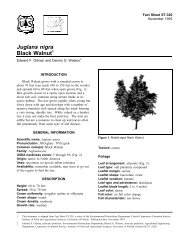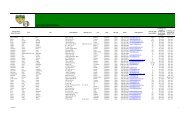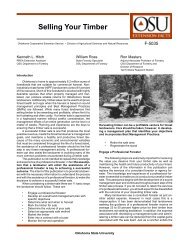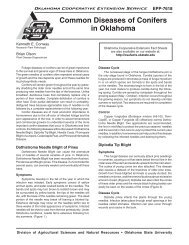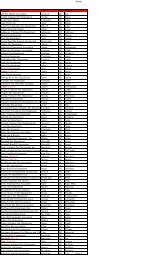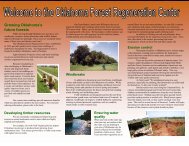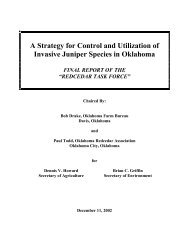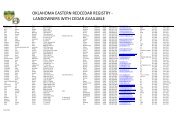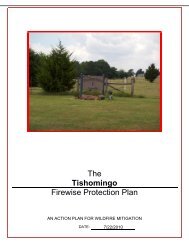Even and Uneven-Aged Forest Management - Oklahoma Forestry ...
Even and Uneven-Aged Forest Management - Oklahoma Forestry ...
Even and Uneven-Aged Forest Management - Oklahoma Forestry ...
Create successful ePaper yourself
Turn your PDF publications into a flip-book with our unique Google optimized e-Paper software.
similar. In an older st<strong>and</strong>, however, crowding <strong>and</strong> competitionbegin to influence tree growth. Some trees will showdominance because of more favorable growing conditions orgenetic factors. Other trees will grow more slowly <strong>and</strong> theywill be suppressed. Thus, an even-aged forest may containtrees with a wide range of diameters. This is shown in Figure3. Note that even-aged forests are sometimes composedof only one species of tree (shortleaf pine for example), butmany times contain several species.Figure 4. In a two-aged forest, there will be two distinctcanopy layers. The overstory will be made up of shadeintolerant trees such as pines. The understory layer willbe made up of shade tolerant trees such as maples,dogwoods, <strong>and</strong> elms.Figure 3. An even-aged forest will be made up of trees withdifferent diameters. These diameters will be distributedin a “bell shaped” fashion about the average diameter.This type of diameter-distribution is indicative of evenagedforests.Timber management in an even-aged forest is consideredto be economically efficient since major operations requireonly one entry into a st<strong>and</strong>. Final harvests involve removingnearly all trees depending upon the regeneration methodchosen. In an even-aged forest, foresters also have the opportunityto replant genetically improved seedlings whichare more disease resistant, grow faster, <strong>and</strong> possess bettertimber <strong>and</strong> visual characteristics.Two-aged <strong>Forest</strong>sA second type of age class distribution is the two-agedforest. A two-aged forest is made up of trees with two verydistinct ages in the same st<strong>and</strong>. Two-aged forests will havetwo distinct canopy layers as shown in Figure 4.The two-aged forest will often be composed of twotree species, one in each age-class. The older group, willbe made up of types of trees that are able to regeneratebarren, exposed areas following disturbances such as l<strong>and</strong>clearing, fire, or clearcut timber harvesting. These tree typeswill normally only grow when full sunlight is available. Pines,cottonwoods, <strong>and</strong> sweetgum are examples of typical treetypes in this group.The second, younger group of trees is a more recentaddition to the forest. These trees evidently were able toregenerate under the canopy of the first group. Only treescapable of growing under less than full sunlight will be foundin this group. These types of trees are said to be “shade-tolerant”<strong>and</strong> include the maples, dogwoods, <strong>and</strong> elms. Otherspecies may also occur which are somewhat shade tolerantsuch as oak, hickory, or ash.<strong>Uneven</strong>-aged <strong>Forest</strong>sConsider a forest made up of three or more age-classes.Further, assume that each different age-class occupiesroughly the same area. Larger trees need more room togrow <strong>and</strong> smaller trees need less. Since each age-class <strong>and</strong>corresponding diameter-class occupy the same area, therewill be fewer big trees <strong>and</strong> many small trees. This situationdescribes an uneven-aged forest.Looking at an three-aged forest from a diameter-classperspective, the difference between even <strong>and</strong> uneven-agedsystems becomes clear. <strong>Uneven</strong>-aged forests typically havemany small trees <strong>and</strong> very few big trees. Figure 5 presentsthe distinction.In this type of forest, young trees will be growing in theshade of older, overtopping trees. An uneven-aged forestwithout human manipulation or natural disturbance will eventuallybe made up of mostly shade-tolerant tree types such asmaple <strong>and</strong> elm which are capable of surviving <strong>and</strong> growingunder these conditions. Assuming some natural disturbanceoccurs, intolerant <strong>and</strong> somewhat intolerant species may bepart of an uneven-aged st<strong>and</strong>.All-aged <strong>Forest</strong>A special type of uneven-aged forest exists if a forestcontains trees in each age class in one year incrementsfrom age one to the oldest. This is referred to by forestersas an “all-aged” forest. For this type of forest to come intoexistence, regeneration of new trees would need to occurevery year. This rare forest situation is represented in Figure6.Timber management in an uneven-aged forest is more5028-2



